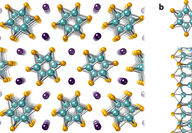Sorted by date Results 1 - 11 of 11

In recent years a great deal of research has gone into creating revolutionary nanomaterials capable of self-assembling into a wide range of dimensional structures at an atomic level. Transition metal chalcogenide (TMC) nanofibers are structures consisting of transition metal atoms such as tungsten, compounded by an element from the oxygen family on the periodic table (like sulfur or tellurium), called chalcogenides. They are known for their unique electrical and optical...

Climate-tech firm Is locking up CO2 into a next-gen carbon material that outperforms energy-intensive building products. Texas-based climate-tech startup DexMat is transforming greenhouse gases into a carbon nanomaterial that is stronger than steel, lighter than aluminum, and as conductive as copper. Boasting many of the superlatives of its carbon cousin graphene, this new wonder material called Galvorn has the earmarks of a futuristic climate-saving building material that can...

Further research on versatile carbon superstructures constructed at nanoscale could revolutionize energy solutions and clean up carbon's image. Burning carbon may no longer be viewed as the popular energy source, but there is still plenty of work to be done in establishing all that sustainably generated power – work that carbon, by its nature, is well-suited to perform. Superstructured carbons (SSCs) are a unique category of cutting-edge nanomaterial that is fast moving out o...

New light-bending nanomaterials may turn science fiction into science fact across AI computing, medical, and entertainment fields. Konstantin Novoselov, co-discoverer of graphene and 2010 Nobel laureate, is among a group of scientists behind a breakthrough that could open the way for even more revolutionary nanomaterial applications similar to graphene, from smart contact lenses to rapid disease detection. Although scientists had long understood that crystal graphene existed,...

Aims to curb industrial heat's CO2 footprint, which is more than cars and planes combined. Climate tech company DexMat and Rice University have received $1.5 million in U.S. Department of Energy funding on a project to replace aluminum or copper fins in heat exchangers with a thermal conductivity-enhanced version of DexMat's flagship product, Galvorn – a high-performance, carbon nanomaterial that is stronger than steel, lighter than aluminum, and as conductive as copper. T... Full story

Polymer tape's sticky properties change when irradiated with UV light. The discovery of graphene – a material with an ever-increasing number of uses – came from the humblest of beginnings: a hunk of graphite, and Scotch tape. Now, tape is once again taking center stage as an unlikely hero of science and technology as researchers from Japan have developed an adhesive with stickiness properties that can be programmed by UV light. Nanomaterials like graphene, which are mere ato...

"At the time, physicists were just starting to talk about the potential of quantum technologies and quantum computers," 36-year-old Mickael Perrin recalled of his career beginnings 12 years ago. "Today there are dozens of start-ups in this area, and governments and companies are investing billions in developing the technology further. We are now seeing the first applications in computer science, cryptography, communications and sensors." Perrin's research has married...

Making some headlines so far this year, a research paper published in "Advanced Quantum Technologies" by leading quantum technology company, Terra Quantum, details a topic that swept the world up in a storm last fall – room temperature superconductors – and much like the excitement of LK-99, this superconductor is also made of a fairly benign ingredient, graphite. Superconductivity is the ability of a conductor to transmit electrical current without the loss of any ene... Full story

As silicon reaches its limits, Georgia Tech and Chinese researchers have created graphene semiconductors that may usher in new era of next-gen electronics. Silicon, which has been the foundational material for computers and electronics over the past seven decades, is reaching its limits in terms of making the next generations of faster and smaller electronic devices. The creation of the world's first graphene semiconductor by a team of researchers at the Georgia Institute of...

A team of researchers led by chemists at San Jose State University has solved the puzzle of how silica-coated nanodiamonds are formed and acquire properties that make them useful in an increasing number of scientific applications. In an article published in the Sept. 15 edition of ACS Nanoscience Au, the researchers described the results of their investigation into the chemistry of silica coatings on nanodiamonds. The study was aimed at helping scientists improve the shells...

Drexel scientists discover titanium nanomaterial that is an extremely efficient hydrogen fuel photocatalyst. Much like many of Mankind's discoveries, such as those that happened through some serendipitous result contrary to the predicted outcome, Drexel University researchers may have stumbled on the method of producing hydrogen fuel – with a photocatalyst 10 times more efficient than the closest commercially viable material. Sustainable technologies produce electricity as t...